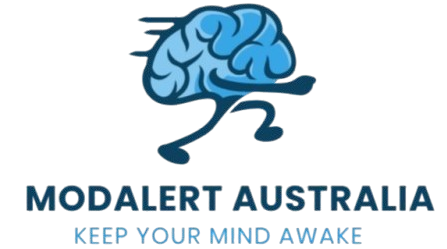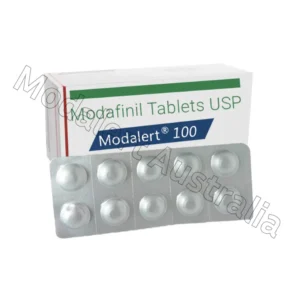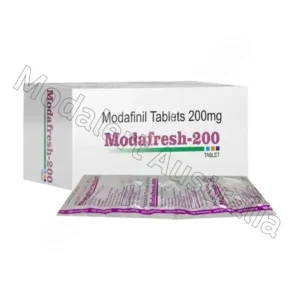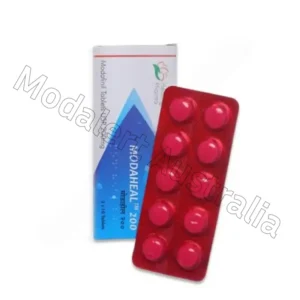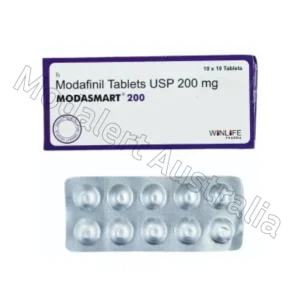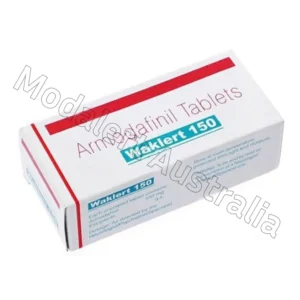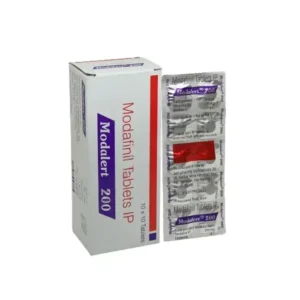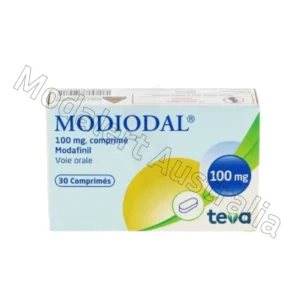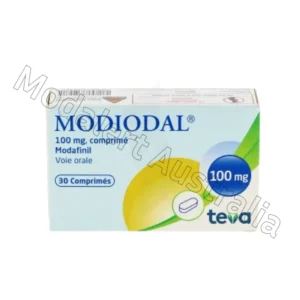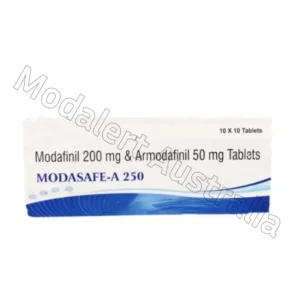Modafinil Mechanism of Action in Narcolepsy
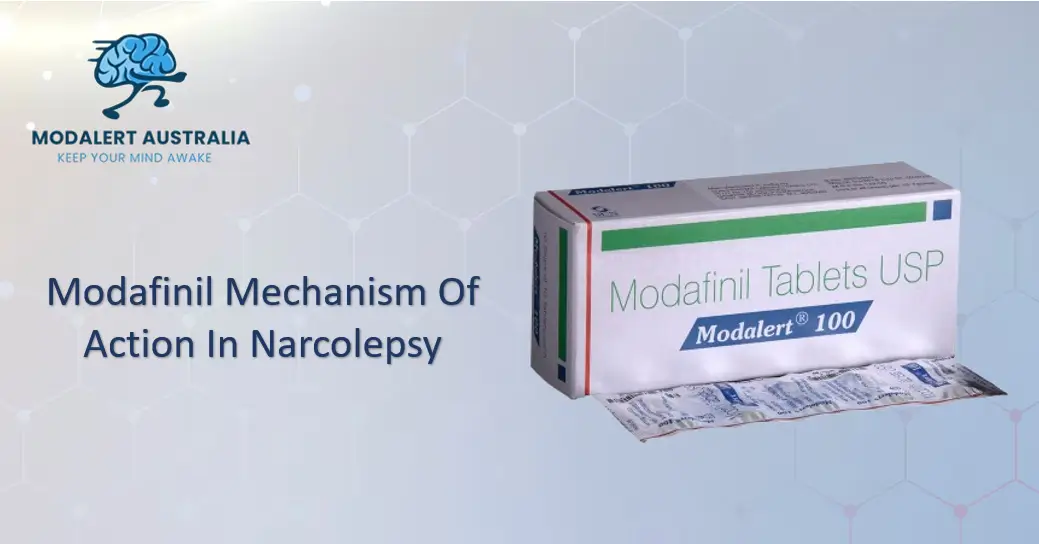
Narcolepsy is a long-lasting neurological disorder that manifests as excessive sleepiness during the day (EDS), as well as cataplexy, hallucinations, and sleep paralysis. It can be classified into two categories:
- Type 1 Narcolepsy (with cataplexy) – It is caused by a shortage of the hormone hypocretin (orexin), which is a neuropeptide that controls wakefulness.
- Type 2 Narcolepsy (without cataplexy) – The exact cause of the problem isn’t fully understood; however, it may be due to different neurotransmitter imbalances.
Modafinil, a wakefulness-promoting agent, is widely used to treat EDS associated with narcolepsy. The exact mechanism behind its action is a mystery and multifactorial, which involves the modulation of multiple brain systems, such as dopamine, norepinephrine, histamine, and orexin.
This article provides an in-depth review of Modafinil’s pharmacological consequences, focusing on interaction with neurotransmitter pathways and receptor binding profiles and its effects on wakefulness and cognition. We also discuss the clinical effectiveness, pharmacokinetics as well as comparisons to other stimulants in the treatment of narcolepsy.
Introduction
The sleep disorder known as narcolepsy is mainly caused by the degeneration of hypocretin (orexin), which produces hypothalamic neurons, disrupting the sleep-wake cycle. Modafinil (2-[(diphenylmethyl)sulfinyl]acetamide) is a first-line treatment for EDS in narcolepsy due to its efficacy and favorable side-effect profile compared to traditional stimulants like amphetamines. In contrast to other stimulants, it increases wakefulness but without any substantial peripheral sympathomimetic effects or a high risk of abuse.
Modafinil’s mechanism isn’t fully known. However, it is believed to involve several neurotransmitter systems, including dopamine, norepinephrine, orexin, and histamine. This article explains Modafinil’s drug action in greater detail, with a focus on the role it plays in managing narcolepsy.
What is Modafinil?
Modafinil (brand name Modalert 200) is a eugeroic (wakefulness-promoting agent) approved by the FDA in 1998 for treating narcolepsy, shift work sleep disorder (SWSD), and obstructive sleep apnea (OSA). Contrary to amphetamines and other stimulants, Modafinil offers a lower chance of dependence and has fewer adverse side effects, so it is a better alternative for long-term treatment.
Chemical Structure
Modafinil (C₁₅H₁₅NO₂S) is a diphenylmethyl sulfinyl compound structurally different from conventional stimulants, such as amphetamines. Armodafinil‘s R-enantiomer is stronger and more effective.
Recommended products
-
Modalert 100 Mg (Modafinil)
$81.12 – $390.00 -
Modafresh 200 Mg (Modafinil)
$70.00 – $245.00 -
Modaheal 200 Mg (Modafinil)
$70.00 – $245.00 -
Modasmart 200 Mg (Modafinil)
$155.00 – $1,115.00
Pharmacodynamics of Modafinil
Dopaminergic Mechanisms
Modafinil’s primary wakefulness-promoting effects are attributed to its interaction with the dopaminergic system:
Dopamine Transporter (DAT) Inhibition: Modafinil is a binder and blocks the dopamine reuptake transporter (DAT), which increases dopamine levels outside of key brain areas like the striatum, nucleus accumbens as well as the Prefrontal cortex (PFC). Dopaminergic neurotransmission is enhanced, increasing the state of alertness.
D1 and D2 Receptor Modulation: Contrary to amphetamines and other stimulants, Modafinil directly stimulates dopamine release; however, it enhances dopaminergic activity by inhibiting dopamine reuptake. Research suggests it could affect D1 as well as D2 receptors, which contribute to cognitive improvement.
Absence of Significant Reward Pathway Activation: Modafinil is considered to be safe for abuse due to the fact that it does not trigger the mesolimbic reward system like amphetamines or cocaine.
Noradrenergic Effects
Norepinephrine Transporter (NET) Inhibition: Modafinil weakly inhibits NET, increasing extracellular norepinephrine in the locus coeruleus (LC), a key wakefulness-promoting region.
Alpha-1 Adrenergic Receptor Activation: The elevated norepinephrine levels increase cortical arousal through alpha-1 receptors. It also assists in the process of promoting wakefulness.
Histaminergic Pathways
Tuberomammillary Nucleus (TMN) Activation: Modafinil indirectly increases the activity of histaminergic neurons located in the TMN and increases histamine release. Histamine enhances sleep through H1 receptors located in the thalamus and cortex.
Interaction with Orexin System: While narcolepsy is a result of orexin deficiencies, Modafinil could partially offset by increasing wake-promoting pathways downstream (e.g. histamine, histamine, as well as norepinephrine).
Glutamatergic and GABAergic Modulation
Increased Glutamate Release: Modafinil increases glutamatergic signalling within the hippocampus and thalamus, which supports the activation of cortical neurons.
Reduced GABAergic Inhibition: Modafinil is believed to reduce GABA release in the sleep-promoting areas and further enhance the state of wakefulness.
Orexinergic Interactions
Compensatory Mechanism in Narcolepsy: Because the loss of orexin neurons characterizes narcolepsy type 1, Modafinil doesn’t immediately restore orexin, but it does amplify other systems of arousal (dopamine and norepinephrine as well as histamine) that usually trigger orexin.
Pharmacokinetics of Modafinil
- Absorption: The drug is well-absorbed and absorbed orally. Peak plasma levels within 2-4 hours.
- Distribution: The binding of proteins is extremely high (~60 %) and the volume of distribution being ~0.9 L/kg.
- Metabolism: Primarily hepatic via the CYP3A4/5 pathway of oxidation. There is also little or no contribution via CYP2C19.
- Elimination: A half-life of between 12 and 15 hours. Most of it is excreted through urine in the form of compounds.
- Food Effects: Foods high in fat slow absorption but are not a significant factor affecting bioavailability.
Clinical Efficacy in Narcolepsy
Wakefulness Promotion
- Multiple RCTs show that Modafinil decreases EDS for patients suffering from narcolepsy as compared with placebo.
- Maintenance of Alertness: Increases the effectiveness of psychomotor vigilance tests (PVT) and decreases the number of unintentional sleep-related events.
Cognitive Enhancement
- Executive Function: Improves attention, working memory, and the ability to make decisions for patients with narcolepsy.
- Reduced Cognitive Fatigue: Modafinil doesn’t result in post-stimulant crashes, contrary to traditional stimulants.
Comparison with Other Stimulants
- Amphetamines: The drug is more potent. However, it has more abuse potential, as well as cardiovascular dangers.
- Methylphenidate: Similar effect; however, Modafinil is less likely to cause adverse side effects for shorter duration.
- Pitolisant (H3 antagonist): Alternative treatment for patients not responsive to Modafinil.
| Feature | Modafinil | Amphetamines | Methylphenidate |
| Mechanism | DAT inhibition, mild NE/5-HT effects | DA/NE release | DAT/NET inhibition |
| Abuse Potential | Low | High | Moderate |
| Side Effects | Mild (headache, nausea) | Severe (hypertension, insomnia) | Moderate (anxiety, tachycardia) |
| Half-life | 12–15 hrs | 4–6 hrs | 3–4 hrs |
Safety and Side Effects
- Common Side Effects: Insomnia, Nausea, Headache, Anxiety.
- Cardiovascular Effects: Little impact on blood pressure/heart rate, compared to amphetamines.
- Psychiatric Effects: Psychosis is a rare occurrence (mostly among predisposed persons).
- Drug Interactions: CYP3A4 stimulators (e.g. carbamazepine) decrease effectiveness; inhibitors (e.g. ketoconazole) raise levels.
Modafinil vs. Armodafinil
- Armodafinil (Nuvigil) is an R-enantiomer for Modafinil that has a greater half-life (15+ hours).
- Higher potency with lower doses, preferred for long-lasting alertness.
Future Research and Development
- Orexin receptor antagonists (e.g. TAK-925) during trials to treat the treatment of narcolepsy.
- Therapy combinations that target different neurotransmitter systems.
Conclusion
Modafinil mechanism of action in narcolepsy is multiple interactions with dopamine and norepinephrine as well as glutamate and histamine systems to compensate for the deficiency of orexin. Its safe profile and continuous wakefulness enhancement can be considered a primary treatment to treat narcolepsy-related EDS. It is necessary to further examine its long-term effects and possible applications to other sleep disorders.
